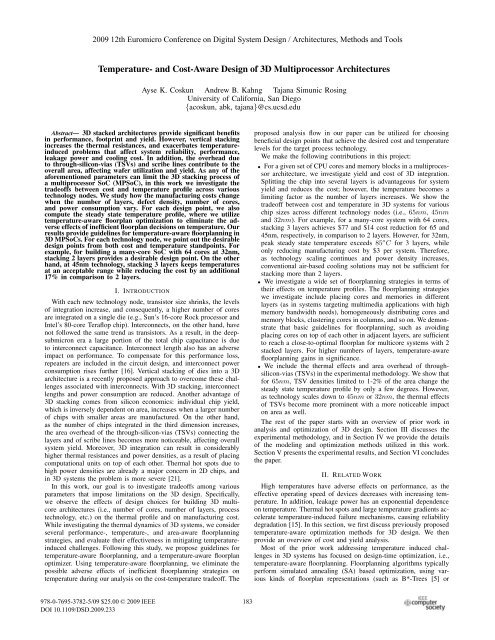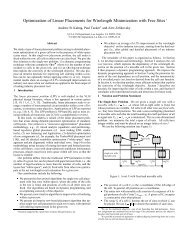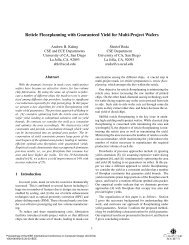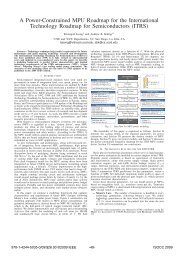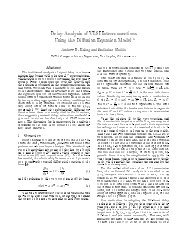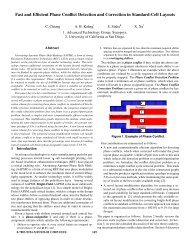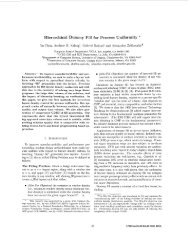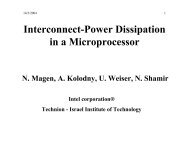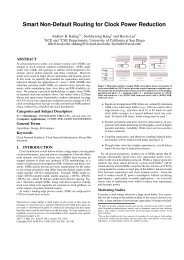DOI - UCSD VLSI CAD Laboratory
DOI - UCSD VLSI CAD Laboratory
DOI - UCSD VLSI CAD Laboratory
Create successful ePaper yourself
Turn your PDF publications into a flip-book with our unique Google optimized e-Paper software.
2009 12th Euromicro Conference on Digital System Design / Architectures, Methods and Tools<br />
Temperature- and Cost-Aware Design of 3D Multiprocessor Architectures<br />
Ayse K. Coskun Andrew B. Kahng Tajana Simunic Rosing<br />
University of California, San Diego<br />
{acoskun, abk, tajana}@cs.ucsd.edu<br />
Abstract— 3D stacked architectures provide significant benefits<br />
in performance, footprint and yield. However, vertical stacking<br />
increases the thermal resistances, and exacerbates temperatureinduced<br />
problems that affect system reliability, performance,<br />
leakage power and cooling cost. In addition, the overhead due<br />
to through-silicon-vias (TSVs) and scribe lines contribute to the<br />
overall area, affecting wafer utilization and yield. As any of the<br />
aforementioned parameters can limit the 3D stacking process of<br />
a multiprocessor SoC (MPSoC), in this work we investigate the<br />
tradeoffs between cost and temperature profile across various<br />
technology nodes. We study how the manufacturing costs change<br />
when the number of layers, defect density, number of cores,<br />
and power consumption vary. For each design point, we also<br />
compute the steady state temperature profile, where we utilize<br />
temperature-aware floorplan optimization to eliminate the adverse<br />
effects of inefficient floorplan decisions on temperature. Our<br />
results provide guidelines for temperature-aware floorplanning in<br />
3D MPSoCs. For each technology node, we point out the desirable<br />
design points from both cost and temperature standpoints. For<br />
example, for building a many-core SoC with 64 cores at 32nm,<br />
stacking 2 layers provides a desirable design point. On the other<br />
hand, at 45nm technology, stacking 3 layers keeps temperatures<br />
at an acceptable range while reducing the cost by an additional<br />
17% in comparison to 2 layers.<br />
I. INTRODUCTION<br />
With each new technology node, transistor size shrinks, the levels<br />
of integration increase, and consequently, a higher number of cores<br />
are integrated on a single die (e.g., Sun’s 16-core Rock processor and<br />
Intel’s 80-core Teraflop chip). Interconnects, on the other hand, have<br />
not followed the same trend as transistors. As a result, in the deepsubmicron<br />
era a large portion of the total chip capacitance is due<br />
to interconnect capacitance. Interconnect length also has an adverse<br />
impact on performance. To compensate for this performance loss,<br />
repeaters are included in the circuit design, and interconnect power<br />
consumption rises further [16]. Vertical stacking of dies into a 3D<br />
architecture is a recently proposed approach to overcome these challenges<br />
associated with interconnects. With 3D stacking, interconnect<br />
lengths and power consumption are reduced. Another advantage of<br />
3D stacking comes from silicon economics: individual chip yield,<br />
which is inversely dependent on area, increases when a larger number<br />
of chips with smaller areas are manufactured. On the other hand,<br />
as the number of chips integrated in the third dimension increases,<br />
the area overhead of the through-silicon-vias (TSVs) connecting the<br />
layers and of scribe lines becomes more noticeable, affecting overall<br />
system yield. Moreover, 3D integration can result in considerably<br />
higher thermal resistances and power densities, as a result of placing<br />
computational units on top of each other. Thermal hot spots due to<br />
high power densities are already a major concern in 2D chips, and<br />
in 3D systems the problem is more severe [21].<br />
In this work, our goal is to investigate tradeoffs among various<br />
parameters that impose limitations on the 3D design. Specifically,<br />
we observe the effects of design choices for building 3D multicore<br />
architectures (i.e., number of cores, number of layers, process<br />
technology, etc.) on the thermal profile and on manufacturing cost.<br />
While investigating the thermal dynamics of 3D systems, we consider<br />
several performance-, temperature-, and area-aware floorplanning<br />
strategies, and evaluate their effectiveness in mitigating temperatureinduced<br />
challenges. Following this study, we propose guidelines for<br />
temperature-aware floorplanning, and a temperature-aware floorplan<br />
optimizer. Using temperature-aware floorplanning, we eliminate the<br />
possible adverse effects of inefficient floorplanning strategies on<br />
temperature during our analysis on the cost-temperature tradeoff. The<br />
proposed analysis flow in our paper can be utilized for choosing<br />
beneficial design points that achieve the desired cost and temperature<br />
levels for the target process technology.<br />
We make the following contributions in this project:<br />
• For a given set of CPU cores and memory blocks in a multiprocessor<br />
architecture, we investigate yield and cost of 3D integration.<br />
Splitting the chip into several layers is advantageous for system<br />
yield and reduces the cost; however, the temperature becomes a<br />
limiting factor as the number of layers increases. We show the<br />
tradeoff between cost and temperature in 3D systems for various<br />
chip sizes across different technology nodes (i.e., 65nm, 45nm<br />
and 32nm). For example, for a many-core system with 64 cores,<br />
stacking 3 layers achieves $77 and $14 cost reduction for 65 and<br />
45nm, respectively, in comparison to 2 layers. However, for 32nm,<br />
peak steady state temperature exceeds 85 o C for 3 layers, while<br />
only reducing manufacturing cost by $3 per system. Therefore,<br />
as technology scaling continues and power density increases,<br />
conventional air-based cooling solutions may not be sufficient for<br />
stacking more than 2 layers.<br />
• We investigate a wide set of floorplanning strategies in terms of<br />
their effects on temperature profiles. The floorplanning strategies<br />
we investigate include placing cores and memories in different<br />
layers (as in systems targeting multimedia applications with high<br />
memory bandwidth needs), homogeneously distributing cores and<br />
memory blocks, clustering cores in columns, and so on. We demonstrate<br />
that basic guidelines for floorplanning, such as avoiding<br />
placing cores on top of each other in adjacent layers, are sufficient<br />
to reach a close-to-optimal floorplan for multicore systems with 2<br />
stacked layers. For higher numbers of layers, temperature-aware<br />
floorplanning gains in significance.<br />
• We include the thermal effects and area overhead of throughsilicon-vias<br />
(TSVs) in the experimental methodology. We show that<br />
for 65nm, TSV densities limited to 1-2% of the area change the<br />
steady state temperature profile by only a few degrees. However,<br />
as technology scales down to 45nm or 32nm, the thermal effects<br />
of TSVs become more prominent with a more noticeable impact<br />
on area as well.<br />
The rest of the paper starts with an overview of prior work in<br />
analysis and optimization of 3D design. Section III discusses the<br />
experimental methodology, and in Section IV we provide the details<br />
of the modeling and optimization methods utilized in this work.<br />
Section V presents the experimental results, and Section VI concludes<br />
the paper.<br />
II. RELATED WORK<br />
High temperatures have adverse effects on performance, as the<br />
effective operating speed of devices decreases with increasing temperature.<br />
In addition, leakage power has an exponential dependence<br />
on temperature. Thermal hot spots and large temperature gradients accelerate<br />
temperature-induced failure mechanisms, causing reliability<br />
degradation [15]. In this section, we first discuss previously proposed<br />
temperature-aware optimization methods for 3D design. We then<br />
provide an overview of cost and yield analysis.<br />
Most of the prior work addressing temperature induced challenges<br />
in 3D systems has focused on design-time optimization, i.e.,<br />
temperature-aware floorplanning. Floorplanning algorithms typically<br />
perform simulated annealing (SA) based optimization, using various<br />
kinds of floorplan representations (such as B*-Trees [5] or<br />
978-0-7695-3782-5/09 $25.00 © 2009 IEEE<br />
<strong>DOI</strong> 10.1109/DSD.2009.233<br />
183
Normalized Polish Expressions [23]). One of the SA-based tools<br />
developed for temperature-aware floorplanning in 2D systems is<br />
HotFloorplan [23].<br />
Developing fast thermal models is crucial for thermally-aware<br />
floorplanning, because millions of configurations are generated during<br />
the SA process. Some of the typically used methods for thermal<br />
modeling are numerical methods (such as finite element method<br />
(FEM) [7]), compact resistive network [24], and simplified closedform<br />
formula [6]. Among these FEM-based methods are the most<br />
accurate and the most computationally costly, whereas closed-form<br />
methods are the fastest but have lower accuracy.<br />
In [8], Cong et al. propose a 3D temperature-aware floorplanning<br />
algorithm. They introduce a new 3D floorplan representation called<br />
combined-bucket-and-2D-array (CBA). The CBA based algorithm<br />
has several kinds of perturbations (e.g., rotation, swapping of blocks,<br />
interlayer swapping, etc.) which are used to generate new floorplans<br />
in the SA engine. A compact resistive thermal model is integrated<br />
with the 3D floorplanning algorithm to optimize for temperature. The<br />
authors also develop a hybrid method integrating their algorithm with<br />
a simple closed-form thermal model to get a desired tradeoff between<br />
accuracy and computation cost.<br />
Hung et al. [14] take the interconnect power into account in<br />
their SA-based 3D temperature-aware floorplanning technique, in<br />
contrast to most of the previous work in this area. Their results<br />
show that excluding the interconnect power in floorplanning can<br />
result in under-estimation of peak temperature. In Healy et al.’s<br />
work on 3D floorplanning [11], a multi-objective floorplanner at the<br />
microarchitecture level is presented. The floorplanner simultaneously<br />
considers performance, temperature, area and interconnect length.<br />
They use a thermal model that considers the thermal and leakage<br />
inter-dependence for avoiding thermal runaway. Their solution consists<br />
of an initial linear programming stage, followed by an SA-based<br />
stochastic refinement stage.<br />
Thermal vias, which establish thermal paths from the core of a chip<br />
to the outer layers, have the potential to mitigate the thermal problems<br />
in 3D systems. In [26], a fast thermal evaluator based on random<br />
walk techniques and an efficient thermal via insertion algorithm are<br />
proposed. The authors show that, inserting vias during floorplanning<br />
results in lower temperatures than inserting vias as a post-process.<br />
Cost and yield analyses of 3D systems have been discussed<br />
previously, as in [18] and [10]. However, to the best of our knowledge,<br />
a joint perspective on manufacturing cost and thermal behavior of<br />
3D architectures has not been studied before. In this work, we<br />
analyze the tradeoffs between temperature and cost with respect to<br />
various design choices across several different technology nodes. For<br />
thermally-aware floorplanning of MPSoCs, we compare several wellknown<br />
strategies for laying out the cores and memory blocks against<br />
floorplanning with a temperature-aware optimizer. In our analysis,<br />
we use an optimization flow that minimizes the steady state peak<br />
temperature on the die while reducing the wirelength and footprint<br />
to achieve a fair evaluation of thermal behavior. Our experimental<br />
framework is based on the characteristics of real-life components,<br />
and it takes the TSV effects and leakage power into account.<br />
III. METHODOLOGY<br />
In this section we provide the details of our experimental methodology.<br />
In many-core SoCs, the majority of the blocks on the die are<br />
processor cores and on-chip memory (e.g., typically L2 caches). We<br />
do not take the other blocks (I/O, crossbar, memory controller, etc)<br />
into account in our experiments; however the guidelines we provide<br />
in this study and the optimization flow are applicable when other<br />
circuit blocks are included in the methodology as well.<br />
A. Architecture and Power Consumption<br />
We model a homogeneous multicore architecture, where all the<br />
cores are identical. We model the cores based on the SPARC core<br />
in Sun Microsystems’s UltraSPARC T2 [19], manufactured at 65nm<br />
technology. The reason for this selection is that, as the number of<br />
cores increase in multicore SoCs, the designers integrate simpler<br />
cores as opposed to power-hungry aggressive architectures to achieve<br />
the desired tradeoff between performance and power consumption<br />
(e.g., Sun’s 8-core Niagara and 16-core Rock processors).<br />
The peak power consumption of SPARC is close to its average<br />
power value [17]. Thus, we use the average power value of 3.2W<br />
(without leakage) at 1.2GHz and 1.2V [17], [19]. We compute<br />
the leakage power of CPU cores based on structure areas and<br />
temperature. For the 65nm process technology, a base leakage power<br />
density of 0.5W/mm 2 at 383K is used [3]. We compute temperature<br />
dependence using Eqn. (1), which is taken from the model introduced<br />
in [12]. β is set at 0.017 for the 65nm technology [12].<br />
P leak = P base · e β(Tcurrent−T 383)<br />
(1)<br />
P base =0.5 · Area (2)<br />
To model cores manufactured at 45nm and 32nm technology<br />
nodes, we use Dennard scaling supplemented by ITRS projections.<br />
If k is the feature size scaling per technology generation, according<br />
to Dennard scaling, for each generation we should observe that<br />
frequency increases by a factor of k, while capacitance and supply<br />
voltage decrease by a factor of k. ITRS projects that supply voltage<br />
almost flatlines as scaling continues, scaling less than 10% per<br />
generation. Using these guidelines, we set the dynamic average power<br />
values of cores as in Table I, based on the equation P ∝ CV 2 f.<br />
TABLE I. P OWER SCALING<br />
Node Voltage Frequency Capacitance Power<br />
65nm 1.2V 1.2GHz C 3.2W<br />
45nm 1.1V 1.7GHz C/1.4 2.72W<br />
32nm 1.0V 2.4GHz C/1.96 2.27W<br />
Each L2 cache on the system is 1 MB (64 byte line-size, 4-<br />
way associative, single bank), and we compute the area and power<br />
consumption of caches using CACTI [25] for 65nm, 45nm and<br />
32nm. At65nm the cache power consumption is 1.7W per each L2<br />
including leakage, and this value also matches with the percentage<br />
values in [17]. The power consumption of each cache block reduces<br />
to 1.5W and 1.2W for 45nm and 32nm, respectively.<br />
The area of the SPARC core in the 65nm Rock processor is<br />
14mm 2 .For45nm and 32nm process technologies, we scale the<br />
area of the core (i.e., area scaling is on the order of the square<br />
of the feature size scaling). The area of the cores and caches for<br />
each technology node are provided in Table II. As the area estimates<br />
for cores and caches are almost equal, we assume the core and<br />
cache areas for 65nm, 45nm, and32nm are 14mm 2 , 7mm 2 ,and<br />
3.5mm 2 , respectively, for the sake of convenience in experiments.<br />
This work assumes pre-designed IP blocks for cores and memories<br />
are available for designing the MPSoC, so the area and dimensions<br />
of the blocks are not varied across different simulations. We assume<br />
a mesh network topology for the on-chip interconnects. Each core is<br />
connected to an L2 cache, where the L2 caches might be private or<br />
shared, depending on the area ratio of cores and memory blocks.<br />
TABLE II. CORE AND CACHE AREA<br />
Technology Core Area Cache Area<br />
65nm 14mm 2 14.5mm 2<br />
45nm 6.7mm 2 6.9mm 2<br />
32nm 3.4mm 2 3.59mm 2<br />
B. Thermal Simulation<br />
HotSpot [24] provides temperature estimation of a microprocessor<br />
at component or grid level by employing the principle of<br />
electrical/thermal duality. The inputs to HotSpot are the floorplan,<br />
package and die characteristics and the power consumption of each<br />
component. Given these inputs, HotSpot provides the steady state<br />
and/or the transient temperature response of the chip. HS3D has<br />
184
TABLE III. PARAMETERS FOR THE THERMAL SIMULATOR<br />
Parameter<br />
Value<br />
Die Thickness (one stack)<br />
0.15mm<br />
Convection Capacitance<br />
140J/K<br />
Convection Resistance<br />
0.1K/W<br />
Interlayer Material Thickness (3D)<br />
0.02mm<br />
Interlayer Material Resistivity (without TSVs) 0.25m K/W<br />
extended HotSpot to 3D architectures [13] by adding a suite of<br />
library functions. HS3D allows the simulation of multi-layer device<br />
stacks, allowing the use of arbitrary grid resolution, and offering<br />
speed increases of over 1000 X for large floorplans. HS3D has<br />
been validated through comparisons to a commercial tool, Flotherm,<br />
which showed an average temperature estimation error of 3 o C,and<br />
a maximum deviation of 5 o C [14].<br />
We utilize HotSpot Version 4.2 [24] (grid model), which includes<br />
the HS3D features, and modify its settings to model the thermal<br />
characteristics of the 3D architectures we are experimenting with.<br />
Table III summarizes the HotSpot parameters. We assume that the<br />
thermal package has cooling capabilities similar to typical packages<br />
available in today’s processors. We calculate the die characteristics<br />
based on the trends reported for 65nm process technology. Changing<br />
the simulator parameters to model different chips and packages<br />
affects the absolute temperature values in the simulation—e.g., thinner<br />
dies are easier to cool and hence result in lower temperatures,<br />
while higher convection resistance means that the thermal package’s<br />
cooling capabilities are reduced and more hot spots can be observed.<br />
However, the relative relationship among the results presented in this<br />
work is expected to remain valid for similar multicore architectures.<br />
HotSpot models the interface material between the silicon layers as<br />
a homogeneous layer (characterized by thermal resistivity and specific<br />
heat capacity values). To model the through-silicon-vias (TSV), we<br />
assume a homogeneous via density on the die. The insertion of TSVs<br />
is expected to change the thermal characteristics of the interface<br />
material, thus, we compute the “combined” resistivity of the interface<br />
material based on the TSV density. We compute the joint resistivity<br />
for TSV density values of d TSV = {8, 16, 32, 64, 128, 256, 512}<br />
per block; that is, a core or a memory block has d TSV vias<br />
homogeneously distributed over its area. For example, in a 2-layered<br />
3D system containing 16 SPARC cores and 16 L2 caches, there<br />
is a total of 16 · d TSV vias on the die. Note that even if we had<br />
wide-bandwidth buses connecting the layers, we would need a lot<br />
less than 256 or 512 TSVs per block. We assume that the effect of<br />
the TSV insertion to the heat capacity of the interface material is<br />
negligible, which is a reasonable assumption, considering the TSV<br />
area constitutes a very small percentage of the total material area.<br />
Table IV shows the resistivity change as a function of the via<br />
density for a 2-layered 3D system with 16 cores and 16 caches. In<br />
our experiments, each via has a diameter of 10μm basedonthe<br />
current TSV technology, and the spacing required around the TSVs<br />
is also 10μm. The area values in the table refer to the total area of<br />
vias, including the spacing.<br />
TABLE IV. E FFECT OF VIAS ON THE INTERFACE RESISTIVITY<br />
#Vias Via Area Area Resistivity<br />
per Block (mm 2 ) Overhead (%) (mK/W )<br />
0 0.00 0.00 0.25<br />
8 0.12 0.05 0.248<br />
16 0.23 0.10 0.247<br />
32 0.46 0.20 0.245<br />
64 0.92 0.40 0.24<br />
128 1.84 0.79 0.23<br />
256 3.69 1.57 0.21<br />
512 7.37 3.09 0.19<br />
IV. TEMPERATURE- AND COST-AWARE OPTIMIZATION<br />
A. Yield and Cost Analysis of 3D Systems<br />
Yield of a 3D system can be calculated by extending the negative<br />
binomial distribution model as proposed in [18]. Eqns. (3) and (4)<br />
show how to compute the yield for 3D systems with known-good-die<br />
(KGD) bonding and for wafer-to-wafer (WTW) bonding, respectively.<br />
In the equations, D is the defect density (typically ranging between<br />
0.001/mm 2 and 0.0005/mm 2 [18]), A is the total chip area to be<br />
split into n layers, α is the defect clustering ratio (set to 4 in all<br />
experiments, as in [22]), A tsv is the area overhead of TSVs, and<br />
P stack is the probability of having a successful stacking operation<br />
for stacking known-good-dies. We set P stack to 0.99, representing<br />
a highly reliable stacking process. Note that for wafer-to-wafer<br />
bonding, per chip yield is raised to the n th power to compute the<br />
3D yield. Wafer-to-wafer bonding typically incurs higher yield loss<br />
as dies cannot be tested prior to bonding. In this work, we only focus<br />
on die-level bonding.<br />
Y system =[1+ D α ( A n + Atsv)]−α P stack n (KGD) (3)<br />
Y system = {[1 + D α ( A n + Atsv)]−α } n (WTW) (4)<br />
The number of chips that can be obtained per wafer is computed<br />
using Eqn. (5) [9]. In the equation, R is the radius of the wafer and<br />
A c is the chip area, including the area overhead of TSVs and scribe<br />
lines. The scribe line overhead of each chip is L s(2 √ A/n + L s),<br />
where L s is the scribe line width (set at 100μm in out experiments).<br />
Note that for a 3D system with n layers, the number of systems<br />
manufactured out of a wafer is U 3d = U/n. Weassumeastandard<br />
300mm wafer size in all of the experiments.<br />
U = πR − 2π √ R + π (5)<br />
A c Ac<br />
Fig. 1. Utilization, Yield and Cost ($). Utilization is normalized with respect<br />
to the 2D chip of equivalent total area.<br />
Once we know the yield and wafer utilization, we compute the<br />
cost per 3D system using Eqn. (6), where C wafer is the cost of the<br />
wafer in dollars. We set C wafer = $3000 in our experiments.<br />
C wafer<br />
C =<br />
(6)<br />
U 3d · Y system<br />
The wafer utilization, yield and cost of systems with a total area<br />
ranging from 100mm 2 to 400mm 2 and with various numbers of<br />
stacked layers are provided in Figure 1. We observe that 3D stacking<br />
improves yield and reduces cost up to a certain number of stacked<br />
layers (n). As n is increased further, yield saturates and then drops<br />
mainly due to the drop in the probability of successfully stacking n<br />
layers (i.e., the Pstack n parameter). These results for yield and cost<br />
motivate computing the desired cost-efficiency points for a given<br />
design before deciding on the number of layers and size of a 3D<br />
architecture. In addition, we see that partitioning chips with area<br />
100mm 2 and below does not bring benefits in manufacturing cost.<br />
185
1 2<br />
3 4<br />
Layer-2<br />
5 6<br />
7 8<br />
Layer-1<br />
NPEs of 2D Layers NPE of 3D System<br />
V<br />
V<br />
H H<br />
H H<br />
1 3 2 4<br />
L L L L<br />
V<br />
H H<br />
1 5 3 7 2 6 8 4<br />
5 7 6 8<br />
Fig. 2. Example NPE Representation.<br />
(1) (2) (3)<br />
LEGEND<br />
Heat Sink<br />
core Spreader<br />
Layer-2 Layer-2 Layer-2 memory<br />
Interface Material<br />
Layer-2<br />
Interface Material<br />
Layer-1 Layer-1 Layer-1<br />
Layer-1<br />
Fig. 3. Known-Good Floorplans for the Example Systems.<br />
B. Temperature-Aware Floorplan Optimization<br />
For a given set of blocks and a number of layers in the 3D<br />
system, we use HotFloorplan [23] for temperature-aware floorplan<br />
optimization. Using a simulated annealing engine, the HotFloorplan<br />
tool can move and rotate blocks, and vary their aspect ratios, while<br />
minimizing a pre-defined cost function.<br />
A commonly used form of cost function in the literature (e.g., [11])<br />
is shown in Eqn. (7), where a, b and c are constants, W is the<br />
wirelength, T is the peak temperature and A is the area. Minimizing<br />
f minimizes the communication cost and power consumption associated<br />
with interconnects, and also minimizes the chip area while<br />
reducing the peak temperature as much as possible.<br />
f = a · W + b · T + c · A (7)<br />
The wirelength component in Eqn. (7) only considers the wires<br />
connecting the cores and their L2 caches in this work. As we<br />
are integrating pre-designed core and cache blocks, the wirelengths<br />
within each block are the same across all simulations. To compute<br />
the wirelength, we calculate the Manhattan distance between the<br />
center of a core and the center of its L2 cache, and weigh this value<br />
based on the wire density between the two units. However, as we are<br />
experimenting with a homogeneous set of cores and caches, the wire<br />
density is the same across any two components, and is set to 1.<br />
We use fixed aspect ratios of cores and memory blocks as in a reallife<br />
many-core SoC design scenario, where IP-cores and memories<br />
with pre-determined dimensions are integrated. This simplification<br />
reduces the simulation time for the floorplanner. Thus, instead of<br />
a two-phase optimization flow of partitioning and then floorplanning<br />
(e.g., [14], [1]), we are able to perform a one-shot optimization, where<br />
the blocks can be moved across layers in the annealing process.<br />
HotFloorplan represents floorplans with Normalized Polish Expressions<br />
(NPEs), which contain a set of units (i.e., blocks in<br />
the floorplan) and operators (i.e., relative arrangement of blocks).<br />
The design space is explored by the simulated annealer using the<br />
following operators: (1) swap adjacent blocks, (2) change relative<br />
arrangement of blocks, and (3) swap adjacent operator and operand.<br />
For 3D optimization, we extend the algorithm in HotFloorplan with<br />
the following operators defined in [14]: (1) Move a block from<br />
one layer to another (interlayer move), and (2) Swap two blocks<br />
between 2 layers (interlayer swap). As we utilize fixed-size cores<br />
and caches in this paper, the interlayer move can be considered as an<br />
interlayer swap between a core or memory and a “blank” grid cell in<br />
the floorplan. These moves still maintain the NPEs, and satisfy the<br />
balloting property (which verifies the resulting NPE as valid) [1].<br />
NPE representations for an example 3D system are provided in<br />
Figure 2. While the letters V and H demonstrate horizontal and<br />
vertical cuts, L represents different stacks in the system.<br />
C. Sensitivity Analysis of the Optimizer<br />
For verification of the optimizer, we compare the results obtained<br />
by the optimizer to known-best results for several experiments. We<br />
use smaller sample 3D systems to reduce the simulation time in<br />
the verification process. All samples are 2-layered 3D systems, and<br />
they have the following number of cores and caches: (1) 4 cores<br />
and 4 memory blocks, (2) 6 cores and 2 memory blocks, and (3) 2<br />
cores and 6 memory blocks. The known-best results are computed<br />
by performing exhaustive search for a fixed footprint area. For each<br />
of the three cases, the optimizer result is the same as the result of<br />
the exhaustive search. The solutions for the example set are shown<br />
in Figure 3.<br />
We also run a set of experiments for larger MPSoCs to verify the<br />
SA-based optimizer: an 8-core MPSoC and an 18-core MPSoC, both<br />
with 4 layers and with equal number of cores and L2 caches. In all of<br />
our experiments, we observe that optimal results avoid overlapping<br />
cores on adjacent layers on top of each other. Therefore, we only<br />
simulate floorplans that do not overlap cores in adjacent layers. When<br />
no cores can overlap, for a 4-layered system without any “blank”<br />
cells (i.e., the core and memory blocks fully utilize the available<br />
area) and with equal areas of caches and cores, there are 3 n different<br />
floorplans. The reason for the 3 n is that, considering a vertical column<br />
of blocks (i.e., blocks at the same grid location on each layer), there<br />
are 3 possible options of cache/core ordering, without violating the<br />
no-overlap restriction. These three possible orderings (from top layer<br />
to bottom layer) are: (1) C-M-C-M, (2) C-M-M-C, and (3) M-C-M-C,<br />
where M and C represent a memory block and a core, respectively.<br />
For the 8-core MPSoC, we simulate all possible floorplans that<br />
abide by the restriction of not overlapping cores and that minimize<br />
the wirelength. This search constitutes a solution space of 3 4 =81<br />
different designs, where all designs have 4 components on each layer<br />
(2x2 grid). For the 18-core MPSoC, similarly we have 9 components<br />
on each layer in a 3x3 grid, and we simulate 1000 randomly selected<br />
floorplans that maintain the same restriction for overlapping cores<br />
(among a solution space of 3 9 floorplans). In both experiments, we<br />
select the floorplan with the lowest steady state peak temperature<br />
at the end. The optimizer result is the same as the best floorplan<br />
obtained in the 8-core experiment. In the 18-core case, the optimizer<br />
results in 1.7 o C lower temperature than the best random solution.<br />
As a second step in the verification process, we perform a study<br />
on how the coefficients in the cost function affect the results of the<br />
optimizer. This step is also helpful in the selection of coefficients.<br />
Note that the area (A) in Eqn. (7) is in hundreds of millimeters,<br />
temperature (T ) in several hundred Kelvin degrees, and wirelength<br />
(W ) is in tens of millimeters. The range of constants used in this<br />
experiment takes the typical values of A, T and W into account.<br />
Fig. 4.<br />
Effect of Cost Function Parameters on Temperature.<br />
Figure 4 demonstrates how the peak steady state temperature<br />
achieved by the floorplan changes when the wirelength coefficient<br />
(a) varies (other constants fixed), and when area coefficient (c) varies<br />
(again other constants fixed). Note that for a 2-layered system with<br />
an equal number of cores and memories, the optimizer minimizes the<br />
wirelength by placing a core and its associated L2 on top of each<br />
other. Therefore, changing the coefficient of the wirelength does not<br />
change the solution as placing a core and its L2 on top of each<br />
other provides the smallest total wire distance. To create a more<br />
interesting case for wirelength minimization, we use a 2-layered 3D<br />
system with core-to-memory ratio (CMR) of 0.5. For investigating the<br />
186
Cost per System ($)<br />
1000<br />
100<br />
10<br />
1<br />
8 16 32 64 8 16 32 64 128 8 16 32 64 128 256<br />
65nm 45nm 32nm<br />
Number of Cores<br />
Fig. 5. Cost Change Across Technology Nodes.<br />
n=1<br />
n=2<br />
n=3<br />
n=4<br />
n=5<br />
n=6<br />
n=10<br />
System ($)<br />
Cost per<br />
140<br />
120<br />
100<br />
80<br />
60<br />
40<br />
20<br />
0<br />
65nm<br />
1 2 3 4 5 6 10<br />
n (# of stacked layers)<br />
D<br />
(1/mm^2)<br />
0.001<br />
0.002002<br />
0.003<br />
0.004<br />
System ($)<br />
Cost per<br />
45<br />
40<br />
35<br />
30<br />
25<br />
20<br />
15<br />
10<br />
5<br />
0<br />
1 2 3 4 5 6 10<br />
n (# of stacked layers)<br />
16 cores<br />
32 cores<br />
64 cores<br />
Fig. 6.<br />
Effect of Defect Density on System Cost.<br />
Fig. 7.<br />
Change in Cost with respect to Number of Cores and Layers.<br />
effect of the area coefficient, we use fewer memory blocks than cores<br />
(CMR =2), to see a more significant effect on peak temperature.<br />
In HotFloorplan, the interconnect delay is computed using a first<br />
order model based on [2] and [20]. While more accurate delay models<br />
exist in literature, such as [4], in our experiments the first order model<br />
is sufficient. This is due to the fact that the floorplanner tends to place<br />
cores and their memories on adjacent layers and as close as possible<br />
to each other to reduce the wirelength (recall that the distance for<br />
vertical wires are much shorter than horizontal ones in general). Thus,<br />
increasing the accuracy of the wire delay model does not introduce<br />
noticeable differences in our experiments.<br />
Based on the results presented, we selected the coefficients as a =<br />
0.4, b =1,andc =4. Similar principles stated above can be utilized<br />
for selecting the coefficients for different 3D systems.<br />
V. EXPERIMENTAL RESULTS<br />
In this section, we discuss the results of our analysis on the<br />
manufacturing cost and thermal behavior of 3D systems. First, we<br />
demonstrate how the cost changes depending on defect density,<br />
number of cores and number of layers for 65nm, 45nm and 32nm<br />
technology nodes. We then evaluate various floorplanning strategies,<br />
and compare the results against our temperature-aware floorplanner.<br />
Finally, the section concludes by pointing out the tradeoffs between<br />
cost and temperature for a wide range of design choices, and<br />
providing guidelines for low-cost reliable 3D system design.<br />
A. Design Space Exploration for 3D System Cost<br />
We summarize the variation of cost across the process technologies<br />
65nm, 45nm and 32nm in Figure 5. In this experiment, the defect<br />
density is set at 0.001/mm 2 , and the core to memory ratio (CMR) is<br />
1 (i.e., each core has a private cache). We compute the cost up to 256<br />
cores for each node, but omit the results in the figure for the cases<br />
where per-system cost exceeds $1000 (note that the y-axis is on a<br />
logarithmic scale). For building MPSoCs with a high number of cores,<br />
3D integration becomes critical for achieving plausible system cost.<br />
Technology scaling provides a dramatic reduction in cost, assuming<br />
that the increase in defect density is limited.<br />
Defect density is expected to increase as the circuit dimensions<br />
shrink. Thus, to evaluate how the cost is affected by the change in<br />
defect density (D), in Figure 6 we show the cost per system in dollars<br />
(y-axis), and the x-axis displays the number of stacked layers in the<br />
system (keeping the total area to be split the same). There are 16 cores<br />
and 16 memory blocks in the 3D architecture (i.e., CMR =1), and<br />
the technology node is 65nm. In all of the experiments in this section,<br />
the TSV count is set to a fixed number of 128 per chip. Especially if<br />
the defect density is high, 3D integration brings significant benefits.<br />
For example, for a defect density of 0.003/mm 2 , splitting the 2D<br />
system into 2 layers reduces the cost by 46%, and splitting into 4<br />
layers achieves a cost reduction of 61%. In the rest of the experiments<br />
we use a defect density of 0.001/mm 2 , representing mature process<br />
technologies.<br />
In Figure 7, we demonstrate the change of cost with respect to<br />
the number of layers and number of cores for 32nm technology.<br />
The CMR is again 1 in this experiment. For the 16-core system,<br />
the minimum cost is achieved for 4 layers, and for the 32-core<br />
case integrating 6 layers provides the minimum system cost. As<br />
the number of cores, or in other words, total area increases, we<br />
may not reach the minimum point for the cost curve by integrating<br />
a reasonable number of layers—e.g., for 64 cores, integrating 10<br />
layers seems to give the lowest cost in the figure, which may result<br />
in unacceptable thermal profiles. Therefore, especially for manycore<br />
systems, an optimization flow that considers both the cost and<br />
temperature behavior is needed, as increasing the number of stacked<br />
layers introduces conflicting trends in thermal behavior and yield.<br />
We observe that TSVs do not introduce noticeable impact on yield<br />
and cost, as long as the ratio of TSV area to chip area is kept lower<br />
than only a few percents. For 45nm technology, the cost difference<br />
between a fixed TSV count of 128 and a fixed TSV percentage of<br />
1% is shown in Figure 8. n demonstrates the number of layers as<br />
before. For example, when we compare keeping the TSV density<br />
at 1% of the chip area against using a fixed number (i.e., 128) of<br />
TSVs per chip, up to 64 cores, the cost difference between the two<br />
cases is below $1. As the number of cores and overall area increase,<br />
accommodating TSVs occupying 1% of the chip area translates to<br />
integrating thousands of TSVs. Thus, for many-core systems, TSV<br />
overhead becomes a limiting factor for 3D design.<br />
B. Thermal Evaluation of 3D Systems<br />
In this section, we evaluate the thermal behavior for various design<br />
choices in 3D systems. To understand the effects of temperature-<br />
187
Temperature (C)<br />
74<br />
72<br />
70<br />
68<br />
66<br />
64<br />
62<br />
exp1<br />
exp2<br />
exp3<br />
exp4ab<br />
exp4ba<br />
exp5ab<br />
exp5ba<br />
exp6_1<br />
exp6_2<br />
exp1b<br />
exp4ab_rot<br />
Fig. 10.<br />
MAX MAX_TSV512<br />
Peak Steady State Temperature Comparison.<br />
Fig. 8. TSV cost difference between using a fixed count and a fixed<br />
percentage (45nm).<br />
exp1 exp2 exp3 exp4ab exp4ba<br />
Layer-2 Layer-2 Layer-2 Layer-2 Layer-2<br />
Layer-1 Layer-1 Layer-1 Layer-1 Layer-1<br />
Gradient (C)<br />
12<br />
10<br />
8<br />
6<br />
4<br />
2<br />
0<br />
exp1<br />
exp2<br />
exp3<br />
exp4ab<br />
MAX GRAD<br />
MAX LAYER GRAD<br />
exp4ba<br />
exp5ab<br />
exp5ba<br />
exp6_1<br />
exp6_2<br />
exp1b<br />
exp4ab_rot<br />
MAX GRAD_TSV512<br />
MAX LAYER GRAD_TSV512<br />
Fig. 11. Comparison of Gradients.<br />
exp5ab<br />
exp5ba<br />
exp6_1<br />
exp6_2<br />
Layer-2<br />
Layer-1<br />
exp1b<br />
Layer-2<br />
Layer-1<br />
Layer-2<br />
Layer-1<br />
exp4ab_rot<br />
Fig. 9.<br />
Layer-2<br />
Layer-1<br />
Layer-2<br />
Layer-1<br />
Floorplans.<br />
Layer-2<br />
Layer-1<br />
LEGEND<br />
core<br />
memory<br />
Heat Sink<br />
Spreader<br />
Interface Material<br />
Layer-2<br />
Interface Material<br />
Layer-1<br />
aware optimization and also to ensure that our results are not<br />
biased by floorplanning decisions, we first analyze the effects of 3D<br />
floorplanning on temperature. All the simulation results shown in this<br />
section are for the 65nm technology.<br />
1) Comparing Floorplanning Strategies: To investigate how floorplanning<br />
affects the thermal profile, we experiment with a 16-core<br />
system with the architectural characteristics described in Section III.<br />
Each core has an L2 cache, so we have a total of 16 cores and 16<br />
memory blocks. The various floorplans we use in our simulations are<br />
summarized in Figure 9.<br />
Figure 10 demonstrates the peak steady state temperature achieved<br />
by each floorplan. MAX shows the results without considering the<br />
TSV modeling, and MAX TSV512 represents the results that take into<br />
account the TSV effect on temperature, with TSV density of 512 per<br />
block. Even though 512 vias per block is a significantly large number,<br />
there is only a slight reduction in the steady state peak temperature<br />
(i.e., less than 1 o C). For this reason, we do not plot the thermal results<br />
with all the TSV densities that we experiment with. For the rest of<br />
the results, we use a TSV density of 512 per block, representing a<br />
best-case scenario for temperature.<br />
For the 2-layer 3D system, exp3, which places all the cores on<br />
the layer adjacent to the heat spreader and all memories in the lower<br />
layer, has the lowest temperature. exp4ab also achieves significant<br />
reduction of peak temperature in comparison to other strategies, and<br />
the wirelength is the same. Note that in both floorplans the core can be<br />
overlapped in adjacent layers with its L2 cache. All the floorplans that<br />
increase the peak temperature (e.g., exp1b) have overlapping cores in<br />
adjacent layers.<br />
In addition to thermal hot spots, large spatial gradients (i.e.,<br />
temperature differences among different locations on the chip) cause<br />
challenges in performance, reliability and cooling efficiency, so<br />
gradients with lower magnitudes are preferable. In Figure 11, we<br />
compare the maximum spatial gradient among the blocks at steady<br />
state. MAX GRAD and MAX LAYER GRAD represent the gradient<br />
across all blocks (considering all layers) and the maximum intralayer<br />
gradient (the gradients across layers are not taken into account),<br />
respectively. The traces with the TSV suffix are from the simulations<br />
including the TSV modeling. We see that exp3 also outperforms the<br />
other strategies for reducing the gradients on the die.<br />
2) The Effect of the Ratio of Core and Memory Area: In Section V-<br />
B.1, all the 3D systems have an equal number and area of cores<br />
and memories. Next, we look into how the change in CMR affects<br />
the thermal behavior. For this experiment, we simulate various CMR<br />
values, but we only show the results for CMR =2and CMR =0.5<br />
as the trends for other ratios are similar.<br />
In Figures 12 and 13, we compare the peak temperature and largest<br />
gradient for the floorplans generated by the optimizer for core-tomemory<br />
area ratios of 2, 0.5, and 1 (baseline). While the peak<br />
temperature is positively correlated with the number of cores, the<br />
temperature gradients increase when the CMR is different than 1.<br />
Thus, separating the core and memory layers as much as possible is<br />
a good solution for reducing the gradients as well.<br />
For 2-layered 3D architectures, following basic guidelines such<br />
as avoiding a vertical overlap of cores (or in general, power-hungry<br />
units), and placing the units with higher power consumption closer to<br />
the heat sink achieve very similar results to the known-best solutions.<br />
These two principles prove to be more significant than avoiding the<br />
placement of cores in adjacent locations horizontally in a multicore<br />
3D system. This general rule-of-thumb holds for any CMR value.<br />
When CMR < 1, separating the cores on the same layer as much<br />
as possible is also necessary for achieving better thermal profiles.<br />
3) The Effect of the Number of Stacks on Temperature: The<br />
purpose of the next experiment is to observe the effect of increasing<br />
188
Fig. 12.<br />
ady State<br />
ature (C)<br />
Peak Stea<br />
Tempera<br />
72<br />
70<br />
68<br />
66<br />
64<br />
62<br />
60<br />
58<br />
CMR-2 CMR-0.5 BASE (CMR-1)<br />
Comparison of Peak Temperature - Core to Memory Area Ratio.<br />
dy State<br />
ture (C)<br />
Peak Stead<br />
Temperat<br />
90<br />
85<br />
80<br />
75<br />
70<br />
65<br />
60<br />
55<br />
50<br />
exp1 exp3 exp4ab<br />
2-layer<br />
4-layer<br />
Maximum m Spatial<br />
Gradie ent (C)<br />
Fig. 13.<br />
5<br />
4<br />
3<br />
2<br />
1<br />
0<br />
CMR-2 CMR-0.5 BASE (CMR-1)<br />
MAX GRAD<br />
MAX LAYER GRAD<br />
Comparison of Gradients - Core to Memory Area Ratio.<br />
the number of stacks on peak steady state temperature and the<br />
temperature gradients. We compare a 2-layered 3D stack architecture<br />
against a 4-layered architecture using the same number of cores and<br />
memories to achieve a fair comparison. In other words, the total<br />
power consumption of the cores and memories are the same in the<br />
2- and 4-layered systems in Figure 14.<br />
Figure 14 compares the peak steady state temperature of the 2-<br />
and 4-layered systems for several floorplanning strategies shown<br />
in Figure 9. In the 4-layered systems, the floorplanning patterns<br />
for upper and lower layers are repeated; e.g., for exp3, wehavea<br />
core layer, a memory layer, again a core layer and a memory layer<br />
(ordered from top layer to bottom). In Figure 15, we demonstrate<br />
the spatial gradients on the systems. For the 4-layered systems, we<br />
observe a significant increase in the gradients across the chip (i.e.,<br />
MAX GRAD). This is because the temperature difference between<br />
the layers close to and far away from the heat sink increases with<br />
higher number of layers in the 3D stack.<br />
In the example shown in Figures 14 and 15, for the 4-layered<br />
stack the footprint reduces by 44% and the system cost decreases by<br />
close to 40% in comparison to using a 2-layered stack (i.e., for a<br />
system that contains the same number of cores and caches). On the<br />
other hand, we see a noticeable increase in temperature. Hence, for<br />
multicore systems, temperature-aware floorplanning becomes crucial<br />
for systems with a higher number of stacked layers.<br />
4) Optimizer Results: We have seen in the last section that for<br />
3D systems with a high number of vertical layers, temperature-aware<br />
optimization is a requirement for reliable design. Figure 16 compares<br />
the optimizer results for a 4-layered 3D system (containing 16 cores<br />
and 16 L2 caches) to the best performing custom strategies investigated<br />
earlier. All the floorplans investigated in Figure 16 have the<br />
same footprint. This is an expected result as we keep the dimensions<br />
of the memory blocks and cores fixed during optimization, and the<br />
optimization flow (which minimizes the total area as well) results in<br />
the same footprint area as the hand-drawn methods. We show the<br />
resulting floorplan of the optimizer in Figure 17, where the darker<br />
blocks are cores, and Layer-4 is the layer closest to heat sink. Note<br />
that there are other floorplans that have the same lowest steady state<br />
peak temperature.<br />
For 4-layered systems, the optimizer achieves an additional 5%<br />
of peak temperature reduction in comparison to the best performing<br />
hand-drawn floorplan. The benefits of optimization are more substantial<br />
for a higher number of stacked layers. As the number of<br />
layers increases, reducing the peak steady state temperature through<br />
floorplan optimization becomes more critical for reducing the adverse<br />
effects of high temperatures at runtime—this is because the dynamic<br />
Gradient (C)<br />
Maximum Spatial<br />
Fig. 15.<br />
Fig. 14.<br />
14<br />
12<br />
10<br />
8<br />
6<br />
4<br />
2<br />
0<br />
Comparison of 2- and 4-Layered Systems.<br />
exp1 exp3 exp4ab<br />
2-layer, MAX_GRAD<br />
4-layer, MAX_GRAD<br />
2-layer, MAX_LAYER_GRAD<br />
4-layer, MAX_LAYER_GRAD<br />
Comparison of Spatial Gradients in 2- and 4-Layered Systems.<br />
temperature range at runtime is highly dependent on the steady state<br />
behavior of the system.<br />
Even though we do not explicitly model the interconnect power<br />
consumption, the accuracy impact of this is expected to be minimal.<br />
This is because all of the floorplanning strategies in this example<br />
(i.e., both custom designed strategies and the optimizer results) place<br />
cores and their associated L2 caches on adjacent layers, and overlap<br />
them to minimize the total amount of interconnects. As noted earlier,<br />
the TSV length is dramatically less than the horizontal interconnects,<br />
as the thickness of the interlayer material is 0.02mm.<br />
C. Investigating the Temperature-Cost Trade-Off<br />
Next we discuss the design tradeoff between cost and temperature<br />
profiles for 65nm, 45nm and 32nm technology nodes. Figure 18<br />
demonstrates the cost per system in dollars and the peak steady state<br />
temperature for the system with 64 cores and 64 L2 caches. All the<br />
thermal results in this section utilize the temperature-aware floorplan<br />
optimizer discussed previously.<br />
The common trend in the figure is that, going from a single layer<br />
chip to 2 layers, both the cost and temperature decrease considerably.<br />
The decrease in temperature is a result of the vertical heat transfer<br />
from the cores to their memories, which have considerably lower<br />
temperatures. Thus, in addition to dissipating heat through the heat<br />
spreader and sink, the cores transfer part of their heat to their caches<br />
and end up with several degrees of cooler temperature. However, if<br />
3D stacking overlaps cores in the adjacent layers (e.g., in the case<br />
where the number of cores is more than that of caches), steady state<br />
temperature is expected to increase.<br />
Also, note that the cost per system drops significantly with each<br />
process technology. This sharp drop results from the simultaneous<br />
increase in yield and wafer utilization when the same chip is<br />
manufactured at a smaller technology node.<br />
Another important observation regarding Figure 18 is that, for<br />
65nm and 45nm, it is possible to reduce the per-system cost<br />
significantly by partitioning the system into 3 layers; i.e, $77 and<br />
$14 reduction for 65nm and 45nm, respectively, in comparison<br />
to building the same system with 2 layers. However, for 32nm,<br />
peak steady state temperature exceeds 85 o C for n =3, while only<br />
reducing the cost by approximately $3. Therefore, as technology<br />
scaling continues and power density increases, it may not be feasible<br />
to stack more than 2 layers for systems with conventional cooling.<br />
189
Peak Tem mperature (C)<br />
88<br />
86<br />
84<br />
82<br />
80<br />
78<br />
76<br />
74<br />
72<br />
70<br />
exp1 exp3 exp4ab OPT<br />
20<br />
18<br />
16<br />
14<br />
12<br />
10<br />
8<br />
6<br />
4<br />
2<br />
0<br />
dient (C)<br />
Grad<br />
Fig. 16.<br />
Peak (Left-Axis) MAX_GRAD (Right-Axis) MAX_LAYER_GRAD (Right-Axis)<br />
Peak Temperature and Gradients - Comparison to Optimizer Results.<br />
Fig. 18. Cost and Temperature for a 64-Core MPSoC: bar graphs show cost<br />
on the left y-axis, and line graphs show peak temperature on the right axis.<br />
Fig. 17.<br />
Optimizer Result for the 4-Layered 16 Core MPSoC.<br />
Also, the heat density increases rapidly for a higher number of<br />
cores. 3D integration for many-core systems in 45nm and below will<br />
require more efficient cooling infrastructures, such as liquid cooling.<br />
VI. CONCLUSION<br />
3D integration is a promising solution for shortening wirelength,<br />
and for reducing the power consumption and delay of interconnects<br />
on SoCs. In addition, partitioning large chips into several layers<br />
increases yield and reduces the cost. One critical issue in 3D design<br />
is that vertical stacking exacerbates the challenges associated with<br />
high temperatures.<br />
In this work, we presented an analysis infrastructure, evaluating<br />
both manufacturing cost and temperature profile of 3D stack architectures<br />
across current and future technology nodes. We utilized a<br />
temperature-aware floorplanner to eliminate any adverse effects of<br />
inefficient placement while evaluating the thermal profile. As a result<br />
of our floorplanning study, we have provided guidelines for thermalaware<br />
floorplanning in 3D architectures. For 3D systems with more<br />
than 2 layers, we showed that using an optimizer provides significant<br />
advantages for reducing peak temperature.<br />
Using our framework, we presented experimental results for a<br />
wide range of assumptions on process technology characteristics and<br />
design choices. For example, for a 45nm many-core SoC with 64<br />
cores, stacking 3 layers cuts the manufacturing cost in half compared<br />
to a single-layer chip, while still maintaining a peak temperature<br />
below 85 o C. When the same system is manufactured at 32nm,<br />
stacking 2 layers and 3 layers reduces the cost by 25% and 32%,<br />
respectively, compared to the 2D chip. However, at 32nm, the steady<br />
state peak temperature for 3 layers reaches 87 o C, due to the increase<br />
in the power density. Such results emphasize that using a joint<br />
evaluation of cost and temperature is critical to achieve cost-efficient<br />
and reliable 3D design.<br />
ACKNOWLEDGEMENTS<br />
The authors would like to thank Prof. Yusuf Leblebici at EFPL for his valuable<br />
feedback. This work has been funded in part by Sun Microsystems, UC<br />
MICRO, Center for Networked Systems (CNS) at <strong>UCSD</strong>, MARCO/DARPA<br />
Gigascale Systems Research Center and NSF Greenlight.<br />
REFERENCES<br />
[1] M. Awasthi, V. Venkatesan and R. Balasubramonian. Understanding the<br />
Impact of 3D Stacked Layouts on ILP. Journal of Instruction Level<br />
Parallelism, 9:1–27, 2007.<br />
[2] K. Banerjee and A. Mehrotra. Global (interconnect) Warming. IEEE<br />
Circuits and Devices Magazine, 17:16–32, September 2001.<br />
[3] P. Bose. Power-Efficient Microarchitectural Choices at the Early Design<br />
Stage. In Keynote Address, Workshop on Power-Aware Computer<br />
Systems, 2003.<br />
[4] L. Carloni, A. B. Kahng, S. Muddu, A. Pinto, K. Samadi and P. Sharma.<br />
Interconnect Modeling for Improved System-Level Design Optimization.<br />
In ASP-DAC, pages 258–264, 2008.<br />
[5] Y.-C. Chang, Y.-W. Chang, G.-M. Wu and S.-W. Wu. B*-Trees: A New<br />
Representation for Non-Slicing Floorplans. In DAC, pages 458–463,<br />
2000.<br />
[6] T. Chiang, S. Souri, C. Chui and K. Saraswat. Thermal Analysis of<br />
Heterogenous 3D ICs with Various Integration Scenarios. International<br />
Electron Devices Meeting (IEDM) Technical Digest, pages 31.2.1–<br />
31.2.4, 2001.<br />
[7] W. Chu and W. Kao. A Three-Dimensional Transient Electrothermal<br />
Simulation System for ICs. In THERMINIC Workshop, pages 201–207,<br />
1995.<br />
[8] J. Cong, J. Wei and Y. Zhang. A Thermal-Driven Floorplanning<br />
Algorithm for 3D ICs. In IC<strong>CAD</strong>, pages 306–313, 2004.<br />
[9] D. K. de Vries. Investigation of Gross Die per Wafer Formula. IEEE<br />
Trans. on Semiconductor Manufacturing, 18(1):136–139, 2005.<br />
[10] C. Ferri, S. Reda and R. I. Bahar. Parametric Yield Management for<br />
3D ICs: Models and Strategies for Improvement. J. Emerg. Technol.<br />
Comput. Syst.(JETC), 4(4):1–22, 2008.<br />
[11] M. Healy, M. Vittes, M. Ekpanyapong, C. S. Ballapuram, S. K. Lim,<br />
H.-H.S.LeeandG.H.Loh. Multiobjective Microarchitectural Floorplanning<br />
for 2-D and 3-D ICs. IEEE Transactions on <strong>CAD</strong>, 26(1):38–52,<br />
Jan 2007.<br />
[12] S. Heo, K. Barr and K. Asanovic. Reducing Power Density Through<br />
Activity Migration. In ISLPED, pages 217–222, 2003.<br />
[13] HS3D Thermal Modeling Tool. http://www.cse.psu.edu/ link/hs3d.html.<br />
[14] W.-L. Hung, G.M. Link, Y. Xie, V. Narayanan and M.J. Irwin. Interconnect<br />
and Thermal-Aware Floorplanning for 3D Microprocessors. In<br />
ISQED, pages 98–104, 2006.<br />
[15] Failure Mechanisms and Models for Semiconductor Devices. JEDEC<br />
publication JEP122C. http://www.jedec.org.<br />
[16] P. Kapur, G. Chandra and K. Saraswat. Power Estimation in Global<br />
Interconnects and Its Reduction Using a Novel Repeater Optimization<br />
Methodology. In DAC, pages 461–466, 2002.<br />
[17] A. Leon, J.L. Shin, K.W. Tam, W. Bryg, F. Schumacher, P. Kongetira,<br />
D. Weisner and A. Strong. A Power-Efficient High-Throughput 32-<br />
Thread SPARC Processor. ISSCC, 42(1):7–16, Jan. 2006.<br />
[18] P. Mercier, S.R. Singh, K. Iniewski, B. Moore and P. O’Shea. Yield<br />
and Cost Modeling for 3D Chip Stack Technologies. In IEEE Custom<br />
Integrated Circuits Conference (CICC), pages 357–360, 2006.<br />
[19] U. Nawathe, M. Hassan, L. Warriner, K. Yen, B. Upputuri, D. Greenhill,<br />
A. Kumar and H. Park. An 8-Core 64-Thread 64-bit Power-Efficient<br />
SPARC SoC. ISSCC, pages 108–590, Feb. 2007.<br />
[20] R. H. J. M. Otten and R. K. Brayton. Planning for Performance. In<br />
DAC, pages 122–127, 1998.<br />
[21] K. Puttaswamy and G. H. Loh. Thermal Herding: Microarchitecture<br />
Techniques for Controlling Hotspots in High-Performance 3D-Integrated<br />
Processors. In HPCA, pages 193–204, 2007.<br />
[22] S. Reda, G. Smith and L. Smith. Maximizing the Functional Yield of<br />
Wafer-to-Wafer 3D Integration. To appear in IEEE Transactions on<br />
<strong>VLSI</strong> Systems, 2009.<br />
[23] K. Sankaranarayanan, S. Velusamy, M. Stan and K. Skadron. A Case<br />
for Thermal-Aware Floorplanning at the Microarchitectural Level. The<br />
Journal of Instruction-Level Parallelism, 8:1–16, 2005.<br />
[24] K. Skadron, M.R. Stan, W. Huang, S. Velusamy, K. Sankaranarayanan<br />
and D. Tarjan. Temperature-Aware Microarchitecture. In ISCA, pages<br />
2–13, 2003.<br />
[25] D. Tarjan, S. Thoziyoor and N. P. Jouppi. CACTI 4.0. Technical Report<br />
HPL-2006-86, HP Laboratories Palo Alto, 2006.<br />
[26] E. Wong and S. Lim. 3D Floorplanning with Thermal Vias. In DATE,<br />
pages 878–883, 2006.<br />
190


